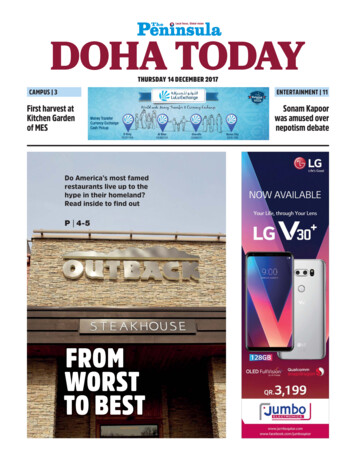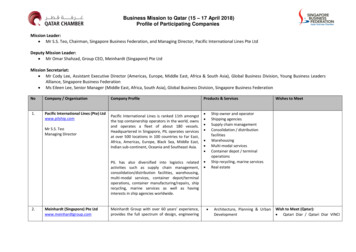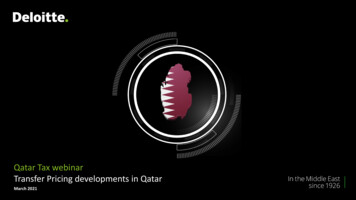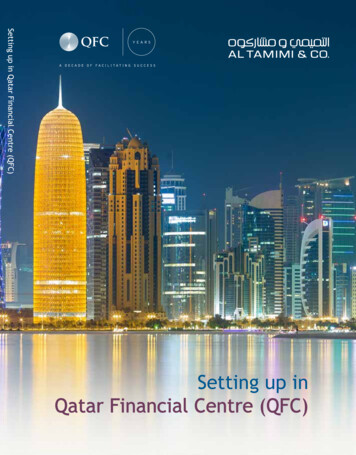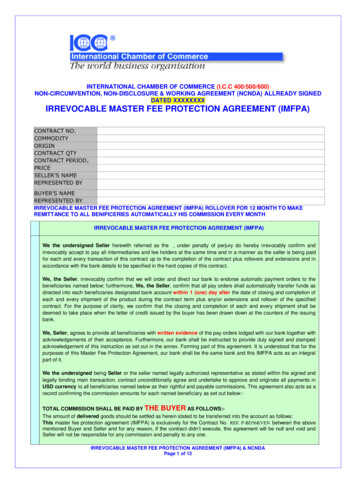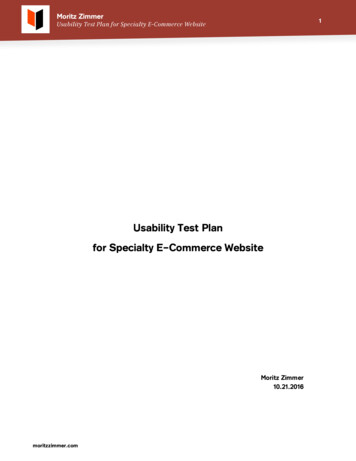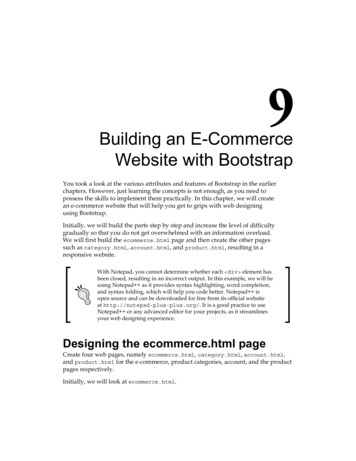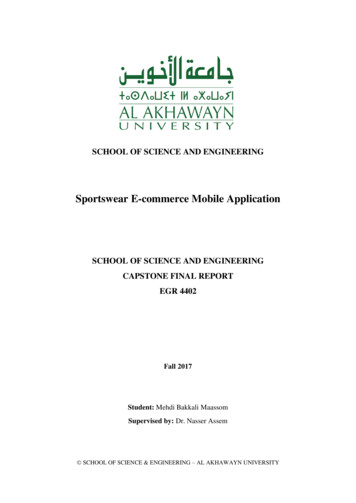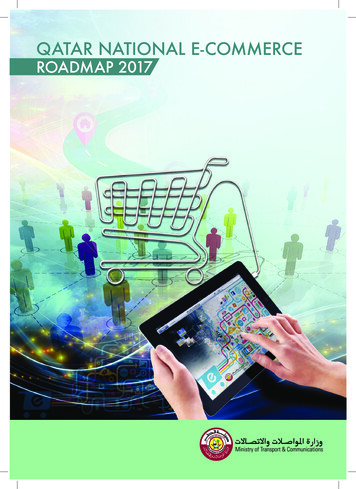
Transcription
QATAR NATIONAL E-COMMERCEROADMAP 2017Qatar National E - commerce Roadmap 20171
2
ContentsContentsForeword 2Introduction 3E-Commerce Landscape in Qatar8B2C Market Insights 10B2B Market Insights 12Key e-Commerce Inhibitors 14A Framework for Growth 16A Plan for Action 20Strengthen the e-Commerce Regulatory Framework21Enable e-Payments 22Enhance Delivery 23Stimulate Consumer Adoption 24Empower Merchants 25Strengthen the e-Commerce Ecosystem26Governance and Monitoring 27Conclusion 27Appendix 28Qatar National E - commerce Roadmap 20171
ForewordForewordDue to major advances in information and communications technology and its continuously changing landscape, the way weperceive and conduct business is rapidly changing as well. The world is experiencing a highly dynamic business environment,with e-commerce becoming more of a business imperative than ever before, supporting economic competitiveness anddiversification. Qatar is part of this trend. With the progress we have made over the past decade in the penetration of ICT intoall facets of life, Qatar is poised to realize favorable social and economic returns from growth in e-commerce.In 2015, Qatar’s business-to-consumer market reached nearly USD 1.2 billion as extrapulated from the 2014 figure of USD 1.02billion at %17 CAGR, making Qatar the seventh-largest market in the MENA region, with significant opportunity for growthand improvement. Qatar already has many of the key ingredients conducive to a favorable e-commerce environment—apopulation with high levels of disposable income, a strong and secure ICT infrastructure, and a highly connected society. Infact, Qatar has the potential to double its forecasted e-commerce market size by leveraging its large investments in both ICTand logistics as well as the growth in its SME sector. Government interventions and coordination are required to realize thispotential and enable a robust e-commerce ecosystem.Recognizing Qatar’s high potential, the Ministry of Transport and Communications (MOTC) has developed this Nationale-Commerce Roadmap to coordinate the implementation effort required to establish a well-governed and well-supportede-commerce ecosystem. It is the result of a detailed analysis of the Qatari e-commerce market combined with local, regional,and global stakeholder consultations, including a broad set of views from the public and private sectors. And it is based onleading practices and latest developments and trends from around the globe.This roadmap is an ambitious blueprint for change that reflects the inclusive effort required for successful implementation.This initiative belongs to all of Qatar, and its success—which will also help drive the continued prosperity and success of thenation—depends on the work and determination of all of us.H.E. Jassim Saif Ahmed Al SulaitiMinister of Transport and Communications2
Qatar National E - commerce Roadmap 20173
IntroductionIntroductionE-commerce is becoming more of a business imperative than ever before as consumer awareness and expectations evolve.The proliferation of high-speed broadband and the availability of a sophisticated Internet infrastructure and Web-enabledmobile devices present increased economic opportunities for government, businesses, and individuals that could haveprofound impact on how future business-to-business (B2B) and business-to-consumer (B2C) commerce is conducted.In 2015, global e-commerce B2C sales totaled USD 1.54 trillion. To get a glimpse into how e-commerce is transforming themarketplace worldwide, one only has to take a look at some of the world’s most successful and popular businesses. Amazon,one of those companies, has no points of sale. Uber, the world’s largest taxi company, owns no vehicles. Netflix, the largestpay TV service, owns no STB or transmission infrastructure. And Alibaba, one of the world’s most valuable retailers, has noinventory.This national e-commerce roadmap is the first of its kind in Qatar. It outlines the current e-commercelandscape in Qatar, details challenges and inhibitors to success, and provides the framework to charta path forward. This roadmap is the result of a thorough collaborative effort with local, regional, and international stakeholdersacross the entire e-commerce value chain—from product creation to consumer receipt of the product—and its successfulimplementation is dependent on strong collaboration and coordination among the different stakeholders.E-commerce has not yet been fully embraced in Qatar, and widespread adoption would have a positive effect on Qatar’sbusiness environment. It could significantly contribute to economic development, a major pillar of the Qatar National Vision,as it provides businesses better access toconsumers, improves business efficiency, expands trade and investment opportunities, and promotes innovation,diversification, and competitiveness. E-commerce also has a direct impact on the remaining three pillars that compose theQatar National Vision as shown in Figure 1.Adoption of e-commerce can benefit small businesses as well as consumers, who will be able to make more informeddecisions and easily conduct commercial transactions. In addition, e-commerce removes the barriers of physical locationand allows consumers to conduct transactions round the clock from the convenience of their homes.From the perspective of business operations, e-commerce allows for more efficiency and increases productivity. The rise ofB2B e-commerce results in the reduction of transaction and coordination costs and improves supply chain management,which can result in reduced business exposure to increasing prices. Moreover, e-commerce offers a business opportunity tologistics and postal operators to expand beyond their traditional roles across the e-commerce value chain.4
Figure 1: How e-Commerce Contributes to Achieving Qatar’s National Vision2030ECONOMIC DEVELOPMENTE-commerce contributes to the evelopment of a Competitive and Diversified Economy Enabling innovative business models, sectoral organization, and market structures Stimulating entrepreneurship and foreign direct investment Fostering the development of target sectors (e.g., logistics, financial services) Ushering in large economic productivity gains through leveraging ICT, and advancingthe drive toward a smarter nationHUMAN DEVELOPMENTE-commerce contributes to the development of Qatar’s Human Capital Accelerating upskilling/ multiskilling trends e.g., digital/ICT management skills),which in turn place demand on the education sector Encouraging continuous training and inter-firmcollaboration, thus enabling innovation Providing an opportunity for consumers to gain access to the best world resources Becoming an inclusion opportunity for low-wage laborer and transientsSOCIAL DEVELOPMENTE-commerce contributes toward a nowledgebased and Just Society Driving the shift toward an economy based onknowledge and information through shaping facets of modern society Stimulating policies that promote the developmentand availability of information technologies and access to advanced networks Providing a sound legal framework to protect consumers throughout the life cycle ofelectronic transactionsENVIRONMENTAL DEVELOPMENTE-commerce contributes toward a Greener Environment Reducing the carbon footprint and energy usage through optimization of inventoriesand transportation services Stimulating social sharing and crowd services, increasing utilization of existing assetsand capabilities Enabling innovative pure digital business models with no physical infrastructures thatcan rely on cloud services, thus resulting in further energy savings and cost efficiencyQatar National E - commerce Roadmap 20175
E-commerce also provides access to electronic markets,facilitating trade, promoting export-oriented businessactivities, and attracting foreign direct investment(FDI). More important, e-commerce sets new frontiersfor innovation and competition, enhances producerbargaining power, and supports omnichannel commercemodels. It can promote the entry of SMEs into the marketand enable them to achieve economies of scale as well asto reach out to consumers currently unavailable to themunder the traditional physical storefront and single-sourcesales channel model.This roadmap engages and targets all stakeholders in thee-commerce value chain:Government institutions play a role in regulating andsupporting both the physical and digital businessenvironment, including payments, and in protectingconsumer rights.Financial institutions enable electronic payments(e-payments) including issuers and acquirers of cards, andemerging e-payment providers (such as aggregators andprocessors).Logistics providers are involved in the delivery of goodsto end-customers and provide local merchants with thelogistics backbone required for more efficient supply chainoperations.6ICT and service providers supply the technology andprofessional capabilities needed to set up, manage,and successfully operate an e-commerce venture. Theyinclude fixed and mobile telecom operators, vendors ofcloud and software solutions, system integrators, mediaagencies, web consulting firms, and other e-commercespecialists in different fields.Merchants include local merchants who are consideringthe setup/enhancement of their online presence as wellas start-ups and foreign investors that are willing to enterQatar’s e-commerce market.Consumers include all those living in Qatar—Qatarinationals, expatriates, and low-wage laborers who are (orwould potentially be) involved in B2C transactions.Consumer also refers to recipients of B2B goods and/orservices.The Ministry of Transport and Communications (MOTC)developed this roadmap through a rigorous andcomprehensive process that involved a broad set ofstakeholder interviews and consultations as well assecondary research, all of which is summarized in the tableon opposite page (see Figure 2).
Figure 2: Sources of Input (not exhaustive)Stakeholders Interviews and ConsultationsGovernmentLogisticsFinancial ServicesMOTCComm’s Regulatory AuthorityM. of JusticeM. of InteriorM. of Economy and CommerceQatar Central BankAramexDHLQatar PostQatar National BankCommercial BankDoha BankQatar Financial CenterQPay InternationalPay FortVisaPayPalTelecomOoredooVodafoneEducationQatar UniversityQatar t InternetMerchantsQatar AirwaysIkeaSparkand many othersReports / AnalysisMOTC PublicationsWorld BankUnited NationsWorld Trade OrganizationWorld Economic ForumInternationalTelecommunications UnionUniversal Postal UnionOECDMasterCardPayPalOvumIpsos ResearchBusiness MonitorInternationalEY ResearchArab Advisors GroupBenchmarkingCountries include:Kingdom of Saudi ArabiaUnited Arab United StatesUnited KingdomMalta,IndiaOrganizations include:Alibaba PayGiroPayQatar National E - commerce Roadmap 20177
E-CommerceLandscape in QatarThe diagram below (Figure 3) provides a snapshot ofQatar’s e-commerce market, and Figure 4 (opposite) detailsmore fully Qatar’s favorable environment for e-commerceadoption.QATAR enjoys a favorable environment for e-commerceadoption, including a population with high levels ofdisposable income; high Internet, mobile, and fixedconnectivity; and increasing ICT maturity. However,several key inhibitors are stopping Qatar from realizing itsfull e-commerce potential. The section below provides anoverview of the state of e-commerce in the country.In Qatar, these factors have translated into the highestaverage annual e-commerce spend per user in the MENAregion and an average value per online transaction higherthan the Gulf Cooperation Council’s (GCC) average. InQatar, the average person spends USD 3,453 per year, witheach transaction approximately USD 264 (see Figure 5).In 2015, the business-to-consumer market was USD 1.2billion as extrapulated from the 2014 figure of USD 1.02billion at %17 CAGR, making Qatar the 7th-largest B2Cmarket in the MENA region. The Qatari economy is one ofMENA’s fastest-growing economies and boasts the world’shighest gross domestic product (GDP) per capita.Figure 3: Snapshot of the Qatar e-Commerce MarketQatar is currently the 7th largest B2C Market in MENA; with tremendous uplift potential .Snapshot of the Qatar e-Commerce MarketMarket SizeChannelsSegmentsAUTOSPORT 10%11%18%15%FASHIONWaiting TimePOPULATION 0.3MSource: Team Analysis* as extrapulated from the 2014 figure of USD 1.02 billion at 17% CAGR8 264 Per TransactionPayments19% 2.3ME-BUYERSAvg. Transaction CREDITCARDS6%PAYPAL75%C.O.D
Figure 4: Qatar’s Economic and Connectivity IndicatorsMENA Selected CountriesGDP / CapitaCountry; GDP / Capita(Current USD ‘000) AlgeriaTotal Country Connectivity (TCCM) MENA*Country ; Internet (%)/ Mobile (%)/Fixed (%) 63Qatar7.4UAE7.31218096Fixed185154ICT Development IndexIndex; CountryKSA7.05Oman6.3Jordan4.75World4.6Europe8GCC Ø 6,0Ø 26Source: ITU; World Bank; Internetworldstats.com; Team AnalysisFigure 5: Qatar’s Average e-Commerce SpendE -Commerce Spend per User per Year (2014)Country; 69UAEEgyptAverage Value per TransactionCountry; USD229KSA977Jordan533215132-72%GCC Ø 238MENA Average 334Source: Qatar ICT Landscape Report 2014, Households and Individuals; eMarketer; Arab Advisors Group; PayPal; IPSOS; World Bank; Insight; Team AnalysisQatar National E - commerce Roadmap 20179
B2C Market InsightsThe B2C MENA market size is approximately USD 40billion, largely dominated by Saudi Arabia and the UnitedArab Emirates. Qatar’s B2C market is the seventh-largest inMENA, with a current market size of nearly USD 1.2 billionand is expected to grow at a compound annual growth rate(CAGR) of 17 percent over the next four years, in line withthe MENA average (see Figure 6)Currently, airline tickets and consumer electronics arethe dominant B2C segments, making up approximately40 percent of the B2C market in Qatar. This B2C marketsegmentation is also in line with the overall MENA B2Cmarket split (see Figure 7)10Despite a favorable environment for e-commerce inQatar, the e-commerce uptake remains relatively low.The percentage of people shopping online represents 14percent of the total population (compared with a regionalaverage of 27 percent), with relatively higher adoptionrates among expatriates and lower rates among Qatarinationals and low-wage laborers (see Figure 8)
Figure 6:Figure6: B2C Market—Regional OutlookUSD bn; Year; Region69,160.80 1.6169.160.69 1.382.202.576.455.52%17 57.281.15 0.571.904.58Jordan37.210.74 1.20 UAE5.50N. tOthers47.010.94 0.471.503.7042.530.85 16201720.0015.90201920182020* North Africa Countries Include: Algeria, Morocco, and Tunisia. Others Include: Syria, Yemen, Lebanon, and IraqSource: eMarketer; Expert Interviews; Team Analysis, World Trade OrganisationFigure 7: B2C Market—Qatar OutlookB2C Qatar Market OutlookUSD bn; Year2.4Major B2C Categories - 2015Percentage (%); Category2.2%3 %3%9%17 2020Qatar B2C market is growing in line withthe MENA averageAirline tickets and electronics are thelargest B2C CategoriesTravelDigital Content and BooksHousehold productsElectronicsHotelsSportFashion & LifestyleEntertainmentAuto partsSource: eMarketer; Expert Interviews; Team Analysis, Nielsen, The State of Payments In The Arab World, PayfortFigure 8: Qatar E-Commerce AdoptionE-Commerce Adoption - Selected MENA CountriesCountry; % AdoptionE -Commerce Adoption in Qatar (Demography)Percentage (%); Demography (%); % Online ne Shoppers Percentage of TotalPopulation (basedon penetration KSAQatarDemography Percentage ofTotal QatarPopulationTotal35AsiansBlue CollarEgypt98Transient- per demography (excludes e-banking)* Calculated as a percentage of total population based on e-commerce penetrationSource: Qatar ICT Landscape Report 2014, Households and Individuals; Arab Advisors Group; PayPal; IPSOS; Team AnalysisMENA Average 27 Qatar National E - commerce Roadmap 201711
The groups not active in e-commerce are concentratedbetween blue collar and transient laborers—who represent54 percent of the total population in Qatar. Fifteen percentof the total population above the age of 20 is not active ine-commerce, and 17 percent of the non-active populationis under the age of 20 (see Figure 9)Moving forward, the segment with the highest potentialfor activity in e-commerce is Westerners and Arab/Asianexpats (Digital Value Seekers) at 29 percent, followed byyoung Qataris and Arabs, Asians, and Westerners with highdisposable income (Digital Shopaholics) at 20 percent.Blue collar and transient laborers will continue to have lowe-commerce potential (%25) (see Figure 10)12B2B Market InsightsThe 2015 B2B market in Qatar is estimated at USD 1.43billion, extrapulated from the 2014 figure of USD 1.3billion, and is expected to grow at a CAGR of 10 percent,a rate higher than the global average. Nevertheless, theB2B market is considered underdeveloped. While theB2B market represents approximately 80 percent of thee-commerce market globally, in Qatar it represents roughly40 percent of the local e-commerce market (see Figure 11)According to the latest SME survey launched by MOTC in2015, the adoption of B2B e-commerce is generally lowin Qatar, with only 7 percent of small to medium-sizeenterprises (SMEs) placing online orders.
Figure 9: Demographic Breakdown of Active/Not Active, Part 1Total Population14Percentage (%); Demographies (Active / Not Active)9% 1%31%Non-active Qatari /Westerner / Arab / Asiansabove 20 years old represent15% of the total Qatarpopulation11%17%Age Group31%0-416%5-913%10 - 1413%12%15 - 19Non-active BlueCollar / Transientrepresent 54% ofthe total Qatarpopulation8620 46%2014Excluding Blue Collar /Transient non-active populationQatariWesternerActiveArabs2014Not ActiveAsiansBlue CollarTransientSource: Qatar ICT Landscape Report 2014, Households and Individuals; Populationpyramid.net; Expert Interviews; Team AnalysisFigure 10: Demographic Breakdown of Active/Not Active, Part 2Percentage (%); Demographies (Active / Not Active)Total Population0%22%1420%17%19%86Digital Value Seeker29%Digital Unconcerned Low Income25%Digital Shopaholic20%Social Digital Shoppers16%Digital Unconcerned High Income11%22%Digital Value Seekers Dominated by Westerners and Arab/Asian expats; will continue to be the largestsegment; key driver is priceDigital Unconcerned Low Income Dominated by blue collar/transient labor; will continue to have lowe-commerce potential; m-commerce (money transfers, simple mobile payments, prepaid telecom services,etc.) is an opportunityDigital Shopaholic Dominated by young Qataris and high-disposable-income Arabs/Asians andWesterners; key drivers are to facilitate e-commerce activity and provide diverse optionsActiveNot ActiveSocial Digital Shopper Dominated by Arab/Asian expats; key drivers are word of mouth and reviews;opportunity for social media t be leveraged to increase e-commerce activity2014Digital Unconcerned High Income Dominated by older Qataris and high-income older Arabs; key driversare availability of Arabic content and diversity in high-quality product offeringsExcluding Blue Collar /Transient non
inventory. This national e-commerce roadmap is the first of its kind in Qatar. It outlines the current e-commerce landscape in Qatar, details challenges and inhibitors to success, and provides the framework to chart a path forward. This roadmap is the result of a thorough collaborative ef
